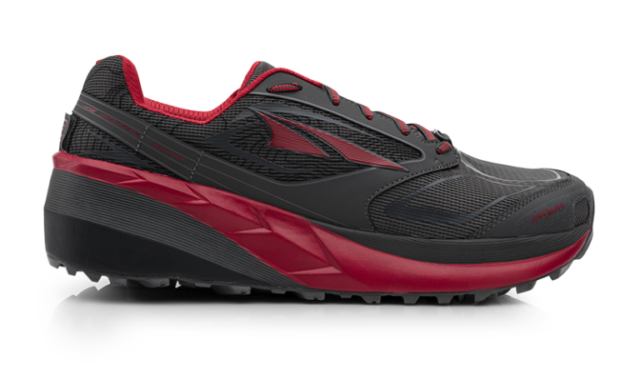
Altra Olympus 3.0
Drop: 0 mm
Stack Height: 33 mm
Stated Features:
- Insole: 5 mm Contour Footbed
- Platform: Fully Cushioned Zero Drop™ platform and FootShape™ toe box
- Midsole: Dual-Layer EVA / A-Bound™ with Innerflex™
- Outsole: TrailClaw with Vibram MegaGrip rubber
- Upper: Abrasion Resistant Mesh with minimal seams
- Other Features: Natural Ride System, 4-Point GaiterTrap™ Technology
MSRP: $150 USD
Size Tested: 10
Stated Weight: 283 g
Blister’s Measured Weight (size 10):
- Shoes + Laces: 309 & 323 g
- Insoles: 24 & 25 g
- Total Weight: 333 & 348 g
Test Locations: Alpenglow Sports Summer Mountain Festival, Lake Tahoe, CA; Fort Collins, Denver, & Gray’s & Torrey’s Peaks, CO
Test Duration: ~300 miles
Reviewer: 5’8”, 155 lbs (my running background and preferences)
Intro
The Olympus is (and has been) Altra’s most cushioned trail shoe for a few years now, and it’s one of the most cushioned trail shoes being made by any manufacturer.
But over the years, the Olympus has gone through a lot of changes. Released this summer, the Olympus 3.0 is the newest iteration, and it’s basically a totally new shoe with a redesigned upper, midsole, and outsole.
Altra says the Olympus 3.0 is “the perfect shoe for ultra distance races, fast packing, and thru-hiking alike.” But what about average, non-superhuman runners who just want a shoe with a lot of cushioning for more moderate trail runs?
I tend to prefer more maximalist-style shoes even for shorter runs, so I was really excited to try out the Olympus 3.0. And after around 80 miles in it, it’s become one of my favorite trail shoes. That said, it’s not going to be for everyone, so here, I’ll go over who should, and who shouldn’t go snag a pair of Olympus 3.0’s.
Olympus 3.0 vs. Olympus 2.5
Altra made several important changes to the Olympus this year, and they describe the differences between the old Olympus 2.5 and new Olympus 3.0 as follows:
“The Olympus 3.0 has been completely revamped for more support, stability and traction on any terrain. The upper mesh is more breathable and durable and features printed mountain graphics, and a 4-point GaiterTrap™. The midsole is more flexible and responsive now thanks to the addition of InnerFlex and shaving down the stack height by 2mm. The Vibram MegaGrip outsole has been widened in the heel area for increased stability, and the middle groove has also been widened for better traction in wet conditions.”
I haven’t run in any of the previous versions of the Olympus, but I have been running in a few other shoes in this class and will offer my comparisons to them below.
Zero Drop
We’ve talked pretty extensively about this in our reviews of the Altra Timp and Escalante, but it’s worth quickly touching on the Olympus 3.0’s zero-drop platform.
This is a defining feature of all Altra shoes, and is very important to consider when figuring out if the Olympus 3.0 might work for you.
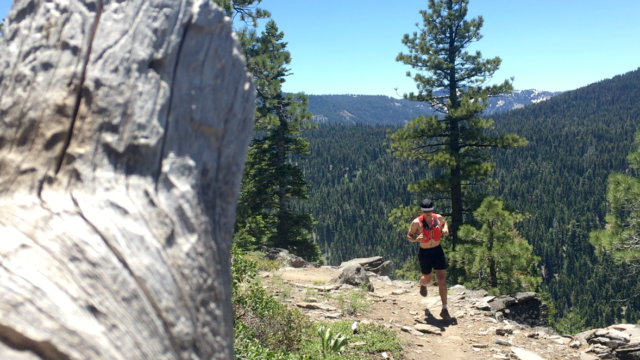
I really like shoes with minimal heel-to-toe drops. They are designed to allow for a more natural stride, and allegedly lead to lower-impact foot landings (which I’d say is true given my experience with the Timp and Olympus 3.0). But if you’re coming from shoes with higher drops (8-12 mm), then we’d strongly encourage you to check out Altra’s transition plan if you decide to switch to a zero-drop shoe.
Zero-drop shoes require a pretty significant change in running style and failing to recognize this can result in injury, so it’s important to keep that in mind if switching from shoes with more traditional heel-to-toe drops.
Fit
As always, we recommend that you try on any shoe before buying it. But with that said, I can offer my thoughts on how the Olympus 3.0 fits my foot. For reference, I have pretty average-volume feet, but I have large lateral splats which mean my midfoot widens when I am standing / running. I also have a fairly low instep. I prefer shoes with wider midfoot areas since that’s where I most commonly experience pain while running.
The Olympus 3.0 is a pretty voluminous shoe all around. It features Altra’s signature FootShape toe box, which means that the shoe is shaped a bit more like a duck’s foot rather than tapering to a point at the toes. The FootShape toe box is designed to let your toes splay out more, and I’d say that’s definitely true with the Olympus 3.0 — I have plenty of room in the toe box.
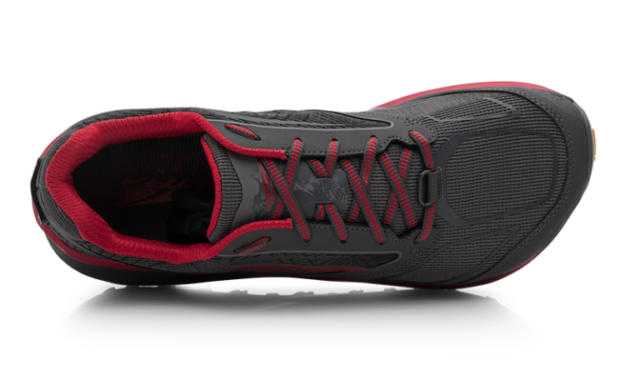
In the midfoot and instep area, the Olympus 3.0 feels slightly higher-volume than the Altra Timp, and significantly wider than the Hoka Speedgoat 2 and Hoka Stinson ATR 4. In the ankle and heel area, I feel like I have a touch more room in the Olympus 3.0 than the Speedgoat 2, Stinson ATR 4, and Timp, but I still haven’t experienced any major issues with heel lift.
If you like a super precise, tight fit in your running shoes, I think you’ll probably find the Olympus 3.0 to feel a bit sloppy. But if you have a wider foot and / or like to have plenty of room for your toes to spread out, then the Olympus 3.0 could be a good option.
Upper
Altra says the Olympus 3.0’s upper is both more breathable and more durable than the last version. While I can’t attest to that since I haven’t used the Olympus 2.5, I have found the Olympus 3.0 to breathe pretty well on hut runs.
Its upper is still thicker and not quite as breathable as the uppers of the Speedgoat 2 and Timp, but I’ve been perfectly happy with the breathability of the Olympus 3.0. That said, I’m not very picky when it comes to the breathability of my shoes, and if you really need a super breathable shoe, there are plenty of options with thinner / more airy uppers.
In general, the Olympus 3.0’s upper falls more on the supportive / stiffer end of the spectrum compared to most trail shoes I’ve used. It has a few overlays that give it some structure, though I haven’t felt any hot spots. And since the shoe has a pretty generous fit, it hasn’t felt restrictive or uncomfortable.
Midsole & Cushioning
If you’re considering the Olympus 3.0, it’s probably at least in part due to its fat, cushy midsole. This is the most cushioned shoe Altra makes, and one of the most cushioned trail shoes on the market. And while the thickness of the midsole is important, I’ve found that the actual on-trail feel of shoes with similar stack heights can vary significantly.
For example, the Altra Timp (29 mm stack height) feels totally different than the Altra Olympus 3.0. The Timp provides a lot more ground feel than any similarly-cushioned shoe I’ve used. And while some people may prefer this, if I’m going to get a shoe with a stack height of around 30 mm, I actually want it to really dampen out the rocks, roots, etc. on the trail. And the Olympus 3.0 does a great job of that.
For a maximalist shoe that’s designed for long runs and / or rough terrain, the cushioning of the Olympus 3.0 feels pretty ideal to me. It’s not super spongy or mushy, but rather it has what I’d call a nice, “progressive” flex. The soft insole gives you a bit of initial “squish”, but I don’t continue to sink into (and through) the Olympus 3.0 like I did in the Timp. The Olympus 3.0 also has a pretty springy feel, which I really appreciate in shoes that are this big and cushioned as it helps them feel a bit less sluggish.

Compared to the Timp, the Olympus 3.0 feels much more springy, and offers much less ground feel. The Olympus 3.0’s midsole feels pretty similar to the Hoka Speedgoat 2, though the Olympus 3.0 is a bit less sensitive (which isn’t saying much, since the Speedgoat 2 offers little ground feel to begin with).
In terms of stiffness, the Olympus 3.0 is a bit softer longitudinally than the Speedgoat 2, and much softer longitudinally and laterally than the Hoka Stinson ATR 4 (which is a pretty stiff shoe overall). Compared to the Altra Timp, the Olympus 3.0 feels a bit stiffer longitudinally and laterally. I like the flex of the Olympus 3.0 — it’s soft enough that I can bend the shoe and engage a lot of the outsole on climbs, but not so soft that it feels unsupportive or really sloppy.
If you want a shoe that lets you feel every little thing on the trail, well, you should probably just stop reading, because the Olympus 3.0 is definitely not that shoe. But if you already know you’re looking for a shoe that offers a lot of cushioning, I think the Olympus 3.0’s midsole works really well for its intended purpose.
Outsole & Traction
The Olympus 3.0 features Altra’s TrailClaw outsole design with Vibram MegaGrip rubber, which is very similar to the outsole on the Timp. I really like the Olympus 3.0’s outsole, and have found it to provide very good traction on pretty much all terrain, except for really deep mud or sand. No complaints here.
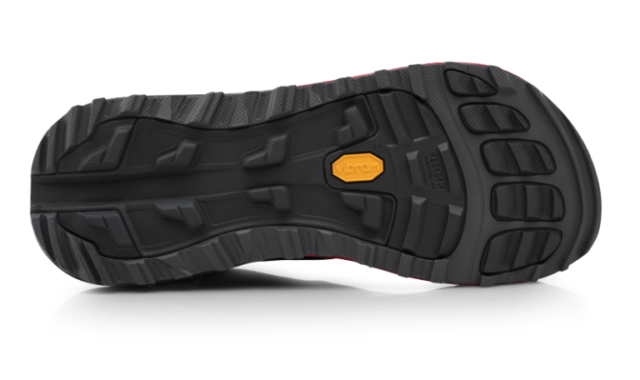
Weight
Surprise! The Olympus 3.0 is not a super light shoe. At around 340 grams per shoe for a size 10, it’s definitely on the heavier side compared to the overall category of trail shoes. But when compared to other similarly cushioned trail shoes, the Olympus 3.0’s weight is actually fairly light. And on trail, I really don’t notice the weight difference between it and the Speedgoat 2 or Timp (though I’m used to running in heavier, more cushioned shoes).
For reference, here are a few of our measured weights (per shoe, in grams) for some relevant shoes.
297 & 297 Hoka One One Speedgoat 2, size 10
335 & 337 Altra Timp, size 10
333 & 348 Altra Olympus 3.0, size 10
333 & 357 Hoka One One Stinson ATR 4, size 10
On the Trail
I’ve spent most of my time in the Olympus 3.0 on the rocky and sandy trails around my house in Fort Collins, CO. Then this past week I also got the chance to use it out on the rocky, rooty, but overall more forgiving trails in Lake Tahoe during the Alpenglow Sports’ Summer Mountain Festival. Overall, the Olympus 3.0 has performed as I expected, and I’ve come to really like this shoe.
As I noted above, the Olympus 3.0 has a fairly springy feel that helps counteract its heavier weight and bulky design. It provides very little ground feel, which I am totally fine with for a shoe with this much cushioning. I’ve never experienced any sort of foot fatigue after running in the Olympus 3.0, which was not the case with the Timp.
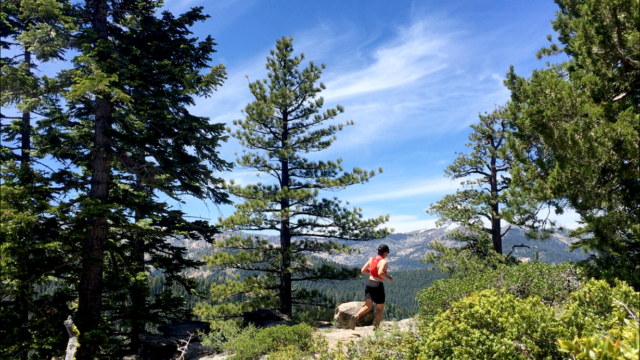
The only real complaint I have with the Olympus 3.0 is in regard to the shoe’s stability. The shoe’s high stack height and pretty voluminous fit make it feel a bit unwieldy on more technical trails. I found myself having to pay closer attention to my foot placement to avoid rolling an ankle in the Olympus 3.0 compared to the Timp and Speedgoat 2.
Of course, any shoe that has as much cushioning as the Olympus 3.0 is not going to feel as stable and precise as less cushioned shoes. This is an inherent tradeoff you have to accept with when it comes to more maximalist-style shoes. And on less rocky and technical trails, I didn’t have any issues with the stability of the Olympus 3.0. But on trails with a lot of off-camber terrain, I definitely felt more confident in the less-cushioned Speedgoat 2 and Timp.
So if you spend a lot of your time running on trails with lots of big rocks or other obstacles, you’ll just have to consider how much you prioritize cushioning vs. stability and precision.
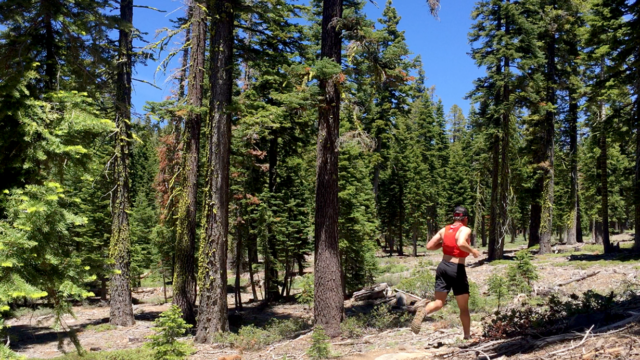
I’ll be spending time in the Hoka Stinson ATR 4 this summer, which has a nearly identical stack height as the Olympus 3.0, so I’m interested to see how stable that shoe feels compared to the Olympus 3.0. And I’ll be posting a long-term update on the Olympus 3.0 with notes on how those two shoes compare.
Durability
After about 80 miles, the Olympus 3.0 is holding up fine. The only issue I’ve noticed is that the lining right next to the top eyelet on one of the shoes is tearing a tiny bit (it’s about a 3mm x 3mm section). I haven’t noticed this while running in the shoe, but I’ll definitely keep an eye on it as I put more miles in the Olympus 3.0. And I’ll include a long-term durability update after I log more miles in it.
Who’s It For?
This is pretty straightforward: if you’re looking for a maximalist, highly-cushioned shoe and aren’t very concerned with ground feel or excellent stability on technical trails, the Olympus 3.0 is a great option. Just be sure to consider the shoe’s more voluminous fit and zero-drop platform before pulling the trigger.
Bottom Line
The Altra Olympus 3.0 is a maximalist trail shoe that does pretty much exactly what it’s supposed to. It mutes out rocks and roots, offers very good traction on most surfaces, and provides plenty of cushioning for long runs on rough trails. Unsurprisingly, it’s not the most stable shoe, and therefore wouldn’t be my top choice for really technical trails. But if you’re willing to give up some precision and stability in exchange for a very plush ride, the Olympus 3.0 is an excellent option.
NEXT: Long-Term Update

Hi Luke,
Thanks for the excellent review, one question remains for me; would you reccomend the [Olympus as a road-to trail shoe?
Were i live my training route is about 15 k, from asphalt (3 k), to forest(7 k), to sand (2k) and another 3 k asphalt back.
I have bunions(so yes, Altra plz) and love full cushioning, but as sais before would you reccomend the Olympus as combi shoe trail/road?
Thanks in advance!
Arne Kleefman,Leusden,NL
Hi Arne,
I’d echo Marc’s comment below re: his experience with the Olympus 2.0. I think the Olympus 3.0 works just fine as a road-to-trail shoe. The lugs on its outsole aren’t enormous, and I never thought it felt wildly out of place while doing short runs on paved roads.
I think the main things to consider will be the potentially faster wear on the sole and the slightly decreased efficiency due to the larger lugs (and for what it’s worth, I didn’t really notice the Olympus 3.0’s outsole on pavement, but people coming from firmer, dedicated-road shoes might).
But especially for runs where you’re only doing around 6-10km of running on asphalt, I think the Olympus 3.0 would be a great road-to-trail option.
– Luke
Hi Marc and Luke,
Thanks alot for your answer and comment, will buy the Olympus 3.0 now:)
Me too :)
Cu soon in NL:P
Hi, I would like to reply to Arne.
I have the Olympus 2.0 , same outsole and I have ran a half marathon on tarmac with them without any issues. And used them for road2trail also, 3k is no problem. Just my opinion.
Marc
Hey Luke,
Any updates on the durability of the outer? How many miles have you put on them so far and how are they holding up? I had the 2.0 and the outer around the pinky toe blew out. Not as bad as my lone peak 2.5s did though.
Hi Tim,
I’ll post a long-term update near the end of this summer, but after around 125 miles, I still haven’t had any major issues. The pinky-toe area of the Olympus 3.0 is reinforced, so that might help prevent that issue, but I’ll report back with a full update in a couple months once I’ve put more miles in them.
Cheers,
Luke
Good to know. 125 is a good amount of miles to know how they’ll hold up. Thanks for responding. Think I’m going to make the plunge. Just about got 400mi on my Timps.
Do you recommend this for long walking on concrete + some light trail? I am doing the Camino de Santiago again next year and I’d like something that can do mostly towns, concrete and then some mountain trails (very easy to moderate), around 16-20miles a day. Would love something that didn’t look too “outdoorsy” too :-) Thanks for the excellent reviews!
I think the Olympus could work pretty well for what you’re describing. That said, there are a couple things to keep in mind.
First, the Olympus’ sticky rubber outsole might be overkill if you’re mostly walking on concrete. But if you don’t mind a bit of extra grip (or prefer it), then that wouldn’t be an issue.
The second thing is the flexibility of the Olympus. Many traditional hiking shoes / boots employ some sort of shank or stiffer (often PU) material in the sole to keep them from flexing as much as running shoes like the Olympus, which uses a softer foam midsole. Many people like the stiffer, more supportive feel of dedicated hiking shoes / boots for really long treks or when carrying a lot of weight on their back since the stiffer midsole offers a more stable feel. But if you’re not carrying a lot of weight and / or have done similarly long walks with other running shoes, then I again think the Olympus could work.
Of the running shoes I’ve used, the Olympus is one of my favorites for longer hikes where I’m not carrying a heavy pack.
Thank you Luke! Is there a different shoe you’d recommend for this use case- especially if I would be carrying a ~ 20lb pack?
There are a ton of options out there and a lot of this depends on fit, so my recommendation would be to go to a trusted outdoor shop and work with their staff to figure out the best option for you. They should have many products to choose from and if you fill in the staff on what your trip is, what your needs are, etc., I think they should be able to provide a better recommendation than I can since they can actually have you try on several different pairs of shoes.
Excellent point.. That way I can buy local as well. Thanks for the excellent blog.
What a nice review, thanks a lot for putting this out .
I tried the Hoka Evo mafate but it’s too narrow for me and I’m looking for wide and plushy shoe for 100 + events , I think I’ll try altra Olympus !
Do you recommend this shoes for over pronating runners?
The Olympus is definitely wider than the Evo Mafate, so I think it’d certainly be worth trying on.
As for your question about pronation, I think this would be best answered by an experienced running shop employee and / or running technique specialist (it’s hard for me to answer without seeing you run, how the shoe fits your foot, etc.). The Olympus doesn’t offer a exceptional support due to its more flexible midsole, so it wouldn’t be my top recommendation if you’re specifically looking for a shoe that will compensate for pronation. But I’d try and find a store that stocks it, try on the shoe, and see if the staff can provide any input.
My comparison. Hoka Stinson vs. Altra Olympus. The Stinson is slightly stiffer a little hard to push of the toes than the Hoka. Also the Hoka traction on climbs is so that u can’t push hard, it’s a little wasted effort because of lack of traction. Cusion seems to be compatible possibly. I noticed brand new Olympus offer more cushion than my Hoka with 200 miles. Not fair comparison. The Hoka is more stable, so there u have it. My Hoka with 200 miles have some wear in the bottom, but the uppers look like new. I washed several times in washer. Both shoes offer wet feet if you are near any moisture what so ever.
I love my Olympus 2.5 for long non-technical runs. However, their biggest shortcoming is their very poor drainage after water crossings. I ran big blisters in them last year in my first 100k and have been looking for an alternative ever since, with no success. How do the 3.0 hold up in wet conditions?
Hmm, I don’t think the Olympus 3.0 would really solve that issue. It drains OK, but it doesn’t have a lot of open spaces in the upper to let water out of, so I’d say it’s still on the lower end of the spectrum when it comes to drainage of water.
I have gone through 2 pairs. Both with 1000km on each. Only as a road shoe.
Hokas keep changing the styles so have stuck with Altra Olympus 3s because of the fit.
I run 100milers on the road and haven’t had any issues.
The lugs last and I do have the same wear on the inside collar. But marginal.
The only draw back as using them as a road shoe, is they are noisy. Takes about 250km to break them in.
I’m impressed.
About to buy my 3rd pair.
I have tried the Torin road ones but they wore down in 300km.
The Olympus sole must be harder wearing.
Hi Luke,
Im wearing Altra TIMP US SIZE 10, feel a bit too roomy for me. To purchase Altra Olympus 3, do you advise to take size 9.5 US men , or just the same size?
Hmm, that’s tough. I got along well with the Olympus and Timp in the same size (my standard running shoe size), but the Olympus is a bit higher volume overall compared to the Timp, so it might work to size down a half size. The only thing I’d be worried about is the overall length, which could be short. But if you’ve run in size 9.5 shoes in the past, then the 9.5 Olympus should work (it runs pretty true to its size).